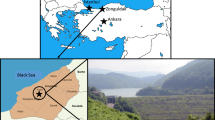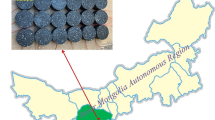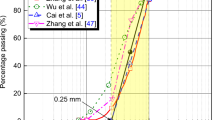Abstract
The degree of deformation of coal under the action of geological structure has important effects on the permeability and gas-bearing properties of a coal reservoir. Therefore, it is critical to understand how the characteristics of coals vary with degree of deformation in coalbed methane (CBM) exploration and exploitation. In this work, Young’s modulus and Poisson’s ratio of coal samples with various degrees of deformation, cored from the CBM wells in South Qinshui Basin, China, were tested with an electro-hydraulic servo-controlled rock mechanic testing system (RMT 150B). Statistical analysis was subsequently conducted with the corresponding P-wave times. The results demonstrate that the destructive effect of geological structure had significant influences on the Young’s modulus of coals. Poisson’s ratio had no significant correlation, but Young’s modulus decreased with increased deformation, and coals can thus be classified into one of three types based on the critical values of Young’s modulus. Further study found that P-wave time had a positive linear correlation with S-wave time in coal samples, and P-wave time is obviously shorter than S-wave time with the same coal. Both P-wave and S-wave times become longer with increased deformation. P-wave time is also linearly correlated with Young’s modulus. Based on well log data, values inferred from the statistical formulas among P-wave time, S-wave time, and Young’s modulus can provide a more accurate classification in terms of the degree of coal deformation.









Similar content being viewed by others
References
Arrey EN (2004) Impact of Langmuir isotherm on production behavior of CBM reservoirs. West Virginia University, USA
Chinese Standard GB/T 6948-2008 (2008) Method of determining microscopically the reflectance of vitrinite in coal. AQSIN and SAC
Chinese Standard GB/T 6949-2010 (2010) Determination of apparent relative density of coal. AQSIN and SAC
Chinese Standard GB/T 8899-1998 (1998). Method of determining maceral group composition and mineral of coal. AQSIN and SAC
Das B (1974) Contortional structures in coal and their effect on the mechanical properties of coal. International Journal of Rock Mechanics and Mining Sciences & Geomechanics Abstracts 11(12):453–457
Fu XH, Qin Y, Wang GX, Victor R (2009) Evaluation of coal structure and permeability with the aid of geophysical logging technology. Fuel 88:2278–2285
Hou Q, Li H, Fan J, Ju YW, Wang TK, Li XS, Wu YD (2012) Structure and coalbed methane occurrence in tectonically deformed coals. Science China Earth Sciences 55(11):1755–1763
Jiang B, Qu ZH, Wang GX, Li M (2010) Effects of structural deformation on formation of coalbed methane reservoirs in Huaibei coalfield, China. Int J Coal Geol 82:175–183
Johanna FB, Silke M, Philipp SL (2015) Architecture, fracture system, mechanical properties and permeability structure of a fault zone in lower Triassic sandstone, upper Rhine graben. Tectonophysics 647-648:132–145
Kang YL, Huang FS, You LJ, Li XC, Gao B (2016) Impact of fracturing fluid on multi-scale mass transport in coalbed methane reservoirs. Int J Coal Geol 154–155:123–135
Karacan CÖ, Ulery JP, Goodman GVR (2008) A numerical evaluation on the effects of impermeable faults on degasification efficiency and methane emissions during underground coal mining. Int J Coal Geol 75:195–203
Laubach SE, Marrett RA, Olson JE, Scott AR (1998) Characteristics and origins of coal cleat: a review. Int J Coal Geol 35:175–207
Li JQ, Liu DM, Yao YB, Cai YD, Qiu YK (2011) Evaluation of the reservoir permeability of anthracite coals by geophysical logging data. Int J Coal Geol 87:121–127
Liu JS, Chen ZW, Derek E, Qu HY, Chen D (2011) Interactions of multiple processes during CBM extraction: a critical review. Int J Coal Geol 87:175–189
Lou Y, Song HQ, Yang JS, Huang XH, Dong H (2013) Productivity equation of fractured well in CBM reservoirs. J Nat Gas Sci Eng 11:39–45
Luke DC, Mazumder S, Regina S, Michael C, Pan ZJ, Deasy H (2016) Laboratory characterization of coal matrix shrinkage, cleat compressibility and geomechanical properties determining reservoir permeability. Int J Coal Geol 165:499–512
Mullen MJ (1989) Log evaluation in well drilled for coalbed methane. Rocky Mountain Association of Geologists, Denver, America, pp 113–124
Pan JN, Hou QL, Ju YW, Bai HL, Zhao YQ (2012) Coalbed methane sorption related to coal deformation structures at different temperatures and pressures. Fuel 102:760–765
Pan JN, Meng ZP, Hou QL, Ju YW, Cao YX (2013) Coal strength and Young’s modulus related to coal rank, compressional velocity and maceral composition. J Struct Geol 54:129–135
Pan JN, Zhu HT, Hou QL, Wang HC, Wang S (2015) Macromolecular and pore structure of Chinese tectonically deformed coal studied by atomic force microscope. Fuel 139:94–101
Scholes PL (1993) Coalbed methane application of wire line logs, hydrocarbons from coal. AAPG 38:287–302
Sławomir K (2011) The occurrence of a secondary zone of coal-bed methane in the southern part of the upper Silesian Coal Basin (southern Poland): potential for methane exploitation. Int J Coal Geol 86:157–168
Tao S, Wang Y, Tang D, Xu H, Lv LM, He W, Li Y (2012) Dynamic variation effect of coal permeability during the coalbed methane development process in the Qinshui Basin, China. Int J Coal Geol 93:16–22
Wang XJ (2007) Influence of coal quality factors on seam permeability associated with coalbed methane production. PhD thesis. University of New South Wales, Sydney, Australia, pp 32–69
Wang Y, Xu XK, Zhang YG (2012) Characteristics of P-wave and S-wave velocities and their relationship with density of six metamorphic kinds of coals. Chin J Geophys 55(11):3754–3761
Warrant JE, Root PJ (1963) The behavior of naturally fractured reservoirs. Soc Pet Eng J 3(3):245–255
Yao YB, Liu DM, Tang DZ, Tang SH, Che Y, Huang WH (2009) Preliminary evaluation of the coalbed methane production potential and its geological controls in the Weibei coalfield, southeastern Ordos Basin, China. Int J Coal Geol 78:1–15
Yao YB, Liu DM (2012) Effects of igneous intrusions on coal petrology, pore-fracture and coalbed methane characteristics in Hongyang, Handan and Huaibei coalfields, north China. Int J Coal Geol 96-97:72–81
Acknowledgements
This work was supported by the National Natural Science Foundation (NNSF) Grant No. 41372162 provided by National Natural Science Foundation of China and University Innovative Research Team (in Science and Technology) Program (14IRTSTHN002) funded by Henan Province.
Author information
Authors and Affiliations
Corresponding author
Rights and permissions
About this article
Cite this article
Zhang, X., Li, P., Yang, Y. et al. Characteristics of P-wave and S-wave times and their relationship with Young’s modulus of coals with different degrees of deformation. Arab J Geosci 10, 75 (2017). https://doi.org/10.1007/s12517-017-2855-x
Received:
Accepted:
Published:
DOI: https://doi.org/10.1007/s12517-017-2855-x




